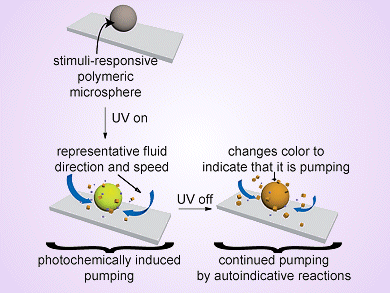Polymer Gel Spheres
Miniaturization is constantly on the march. For example, we now have entire analytical and diagnostic systems that can take place on a chip. These systems require miniaturized versions of macroscopic components and devices. In the journal Angewandte Chemie, American researchers have now introduced a microscopic pump. It is based on polymer gel microparticles and starts up when irradiated with UV light. The extraordinary thing about this device is that the material continues to pump when the stimulus is removed.
The tiny pumps developed by a team led by Ayusman Sen and Scott T. Phillips, Pennsylvania State University, USA, are based on polymer gel spheres with a diameter of 300 µm. Their surface is equipped with two different types of molecules. The first type is split off under UV light, breaking down into CO2, protons, fluoride ions, and a small organic molecule. The trick is that the fluoride ions cause the second type of molecule to split off of the surfaces of the spheres – even when no UV light is present. The second type of molecule also breaks down into CO2, protons, fluoride ions, and a small organic molecule. Because fluoride is constantly being released, the reaction only comes to a halt when all of the type 2 molecules are used up.
How do the spheres “pump”? The molecules and ions they release diffuse away from the surfaces of the spheres and form a concentration gradient. Concentration gradients always produce flow within a liquid: the spheres “suck” the liquid toward themselves. The organic molecule released in the reaction also causes the spheres to change color from white to yellow-orange. This indicates that the micropump is “switched on”.
Materials That Remember
“Intelligent” polymer materials that can “respond” to an external stimulus with a macroscopic function are the subjects of intensive research. The fact that this material “remembers” the initiating stimulus – the UV light – and continues to pump when it is switched off is something completely new for this type of material. The new material requires no reagents or “fuels” to be added through the liquid. It functions autonomously, converting chemical energy into a mechanical response, the flow of liquid. Molecule 1 receives the signal; the fluoride ions transmit it. This is the first time that all these properties have been combined in an “intelligent” polymeric material.
It should also be possible to devise a similar material that reacts to stimuli other than light, such as the presence of a certain substance. Such microscopic pumps could be used to redirect the flow in a microfluidic system as soon as this specific substance appears.
- A Self-Powered Polymeric Material that Responds Autonomously and Continuously to Fleeting Stimuli,
Matthew S. Baker, Vinita Yadav, Ayusman Sen, Scott T. Phillips,
Angew. Chem. Int. Ed. 2013.
DOI: 10.1002/anie.201304333




